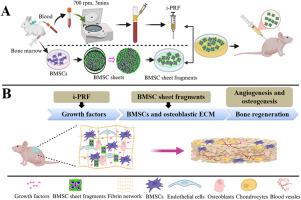The study on the construction of injectable tissue-engineered bone based on the injectable PRF combined with osteoblastic bone marrow mesenchymal stem cell sheets
引用次数: 0
Abstract
Injectable platelet-rich fibrin (i-PRF) has been proven to be able to promote tissue regeneration and applied in the treatment of diseases in the maxillofacial region, but whether it can be used to construct injectable tissue-engineered bone remains inconclusive. The aim of this study was to investigate whether i-PRF combined with osteoblastic bone marrow mesenchymal stem cell (BMSC) sheets can be used to construct injectable tissue-engineered bone. First, i-PRF prepared from fresh blood after a short-time and low-speed centrifugation. BMSCs, after continuous osteogenic induction for 2 weeks, formed membrane-like structures containing calcium nodules. They were mixed and then transplanted subcutaneously in nude mice by injection. the osteogenesis was evaluated through Micro-CT scanning and histological analysis after 8 weeks of transplantation. The group with BMSC sheets alone formed osteoid tissue, but the volume of new bone- and cartilage-like tissue was smaller, more sparse, and unevenly distributed. In contrast, the group with i-PRF and BMSC sheets had larger volumes of new tissue, higher bone density, more mineralized deposits, and more woven bone structures. In summary, osteoblastic BMSC sheets have the potential for ectopic osteogenesis, but i-PRF can significantly enhance their osteogenic capacity. Therefore, i-PRF combined with osteoblastic BMSC sheets can be regarded as a promising method for constructing injectable tissue-engineered bone.

基于可注射PRF结合成骨骨髓间充质干细胞片构建可注射组织工程骨的研究
可注射的富血小板纤维蛋白(i-PRF)已被证明能够促进组织再生并应用于颌面部区域疾病的治疗,但它是否可以用于构建可注射的组织工程骨仍然没有定论。本研究的目的是探讨i-PRF与成骨细胞骨髓间充质干细胞(BMSC)片是否可以用于构建可注射的组织工程骨。首先,从新鲜血液中提取短时间低速离心后制备i-PRF。骨髓间充质干细胞在连续成骨诱导2周后,形成含钙结节的膜样结构。将它们混合后注射到裸鼠皮下。移植8周后通过显微ct扫描和组织学分析评估成骨情况。单独使用BMSC片的组形成了类骨组织,但新生骨和软骨样组织体积更小,更稀疏,分布不均匀。相比之下,使用i-PRF和BMSC片的组具有更大的新组织体积,更高的骨密度,更多的矿化沉积物和更多的编织骨结构。综上所述,成骨骨髓间充质干细胞薄片具有异位成骨的潜力,但i-PRF可显著增强其成骨能力。因此,i-PRF与成骨骨髓间充质干细胞片相结合是一种很有前景的构建可注射组织工程骨的方法。
本文章由计算机程序翻译,如有差异,请以英文原文为准。
求助全文
约1分钟内获得全文
求助全文

 求助内容:
求助内容: 应助结果提醒方式:
应助结果提醒方式:


